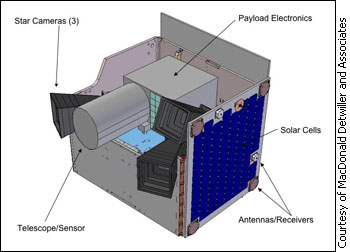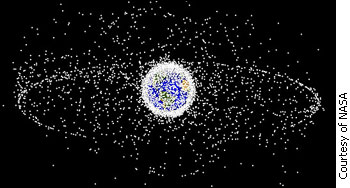The groundbreaking project tasked with this endeavour is
the Sapphire system - an optical surveillance satellite
designed to track objects in deep space.
"The concept is not a complicated one," says Capt.
Paul Maskell, project manager for Sapphire. "The difference
here is that we're providing the sensor up in orbit."
The cube-shaped satellite will be the first of its kind
developed outside the United States, and will be Canada's
first significant contribution to the U.S. Space Surveillance
Network (SSN) in two decades.
 |
| A preliminary model of Canada's Sapphire
system, The satellite will be about one-metre cubed.
It will be presented to the Department of National Defence
for approval in May 2009. |
Although it will not launch until 2011, officials with the
Department of National Defence (DND) say the project is quickly
approaching an important stage in its development.
With its critical design review scheduled for May, Sapphire's
prime contractor - MacDonald Dettwiler and Associates - will
present its design plan to the DND for approval.
If there are any discrepancies then it is back to the drawing
board, Maskell says. Otherwise there is a green light to
proceed with fabrication at the David Florida Laboratories
in Ottawa.
"From there we start cutting metal and building parts,
getting ready to fit them together and test them," the
36-year old says.
After joining the Canadian Forces at the age of 17 as a
navigator on the Sea King helicopter, Maskell completed
a post-graduate degree in space systems a decade ago.
Before Sapphire, he spent four years at Cheyenne Mountain
in Colorado - inside the lion's den of space surveillance
- working for the U.S. Air Force Space Command.
Tapping the source
Maskell says Sapphire will help re-establish a lost link
with the U.S. in the critical area of space surveillance.
Canada has a memorandum of understanding with the
U.S., he says, which will give the DND assured access to
information regarding the orbits of every space object being
tracked by the U.S. military.
With Sapphire's price tag hovering around $96 million,
the Canadian Forces are sparing no expense in the pursuit
of improved space situational awareness - a valuable commodity
in an age of improved
access to outer space for peripheral nations.
"One specific area of interest for Canada is the protection
of its space assets," says Maskell. "I mean we
are talking multi-multi-million dollar satellites."
| 'Now we're realizing
the more stuff we put up there, the more stuff we'll
have to contend with in the future.' |
From a civilian viewpoint, the maintenance of satellites
is integral to many aspects of modern society. Cell phones,
bank machines, global positioning systems, and weather forecasts
all rely on satellites.
From a defence perspective, the need to safeguard satellites
is equally pressing. In combat, the Canadian Forces use satellites
for surveillance, reconnaissance and intelligence gathering,
firing precision guided munitions, navigation and communication,
and aerospace warnings.
Military satellites are the eyes and ears of troops on the
ground, and the protection of these assets - either from
accidental collision with debris or intentional sabotage
at the hands of hostile nations - is vital, says defence
analyst James Fergusson.
"We don't know where the future lies in terms of military
use of outer space," he says. "It is important
to know what's going on up there. It is no different from
how we want to know what is going on within our national
territory, our national airspace, or the waters around us."
Fergusson, who is the director of the Centre for Defence
and Security Studies at the University of Manitoba, says
Canada must be able to identify threats before they materialize.
Space junk
Since the dawn of the space age, thousands of objects
have accumulated in orbits around the Earth and
now pose a serious risk to satellites.
Brad Wallace, head of space surveillance efforts with Defence
Research and Development Canada, says space surveillance
keeps satellites from crashing into debris and each
other.
 |
| A computer generated image of all
the objects in Earth's orbit currently being tracked.
Ninety-five per cent of the objects are pieces debris. |
"Think of it as air-traffic control for outer space," he
says.
Unfortunately this function does not always work.
On Feb. 10, a derelict Russian military satellite collided
with a functioning U.S. Iridium commercial satellite in the
skies over Siberia. The result was a catastrophic smash-up
generating thousands of pieces of new debris.
This latest collision has people talking, and Wallace says
that is exactly what needs to happen. "Now we're realizing
the more stuff we put up there, the more stuff we'll have
to contend with in the future."
The last time space debris garnered this much international
attention was in January 2007, after China destroyed a defunct
weather satellite with an anti-satellite (ASAT) missile.
Space is an international domain and there should be cooperation
to help prevent future increases in space pollution, he says.
For the time being, however, it's a problem that lacks a
clear-cut solution. Space surveillance is the only line of
defence against debris, and Sapphire will be Canada's contribution
to the cause.
Frontpage photo courtesy of MacDonald Detwiller and
Associates Ltd.
|

